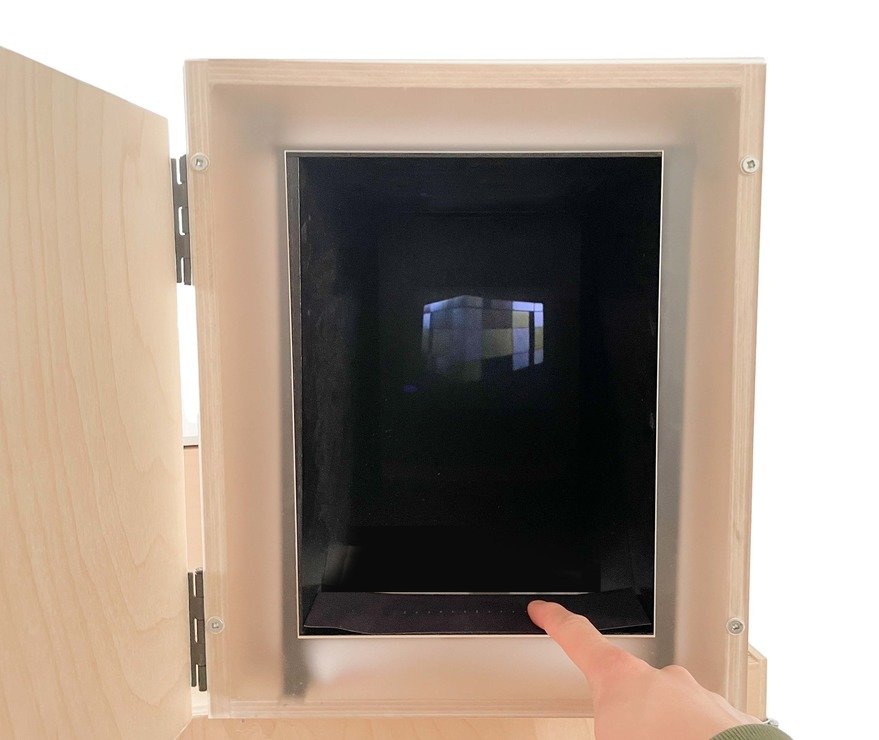Student Notable
Design for Social Impact Award
Core77 Design Awards 2022
Open Door Museum
Problem
Museum exhibitions provide a window into our culture but often fail to represent the community they reside in. We strive to tackle this by building a platform where residents become the curators.
Why
Through the Open Door Museum, we hope to amplify the community's voice through a system of exhibitions where community members become the curators and share their stories and cherished objects. We want to provide an alternate purpose for museums when taken out into the public, where they can more easily facilitate community members into building a collective identity through objects.
How
We designed and prototyped a pair of hardware-integrated cabinets: one cabinet to scan in objects people submit and one cabinet to display that scanned object through holographic projection.
What
A museum is an exclusive environment that only people with the financial means can afford to visit. Furthermore, museums often don't reflect the communities they are embedded in as what museum curators decide to present in their exhibitions often don't reflect the community.



The origin of museums is the "Cabinet of Curiosities," a literal cabinet owned by wealthy aristocrats to share their personal history through extraordinary objects. This narrow collection defined by wealth and class has persisted to museums today, where diverse perspectives are missing and visitors feel distant from the artifacts on display. ?
By bringing museums out into the streets, they can serve as thoughtful facilitators of our culture. Open Door Museum achieves this through a network of cabinets across Pittsburgh, Pennsylvania. By asking participants to visit the cabinet and scan their artifact, Open Door Museum encourages a deeper reflection on their individual identity through the lens of an object. By viewing other artifacts submitted by community members, visitors can contextualize their culture in the context of the collective. It incorporates the foundational elements of museums, where visitors can learn more about objects they aren't familiar with, while adding relatability through audio-recorded personal stories.
Our design process began with a visit to the Carnegie Museum Of Art's Extraordinary Ordinary Things Exhibit. With a brief from the museum to imagine the role of museums outside the museum space, we drew observational analyses to initiate our concept. After thoughtful discussions and user interviews, we drafted our proposal of democratizing museum curation through a network of community museums. After receiving positive feedback from CMOA's curators and external critics, we focused much of our effort into "thinking through making." We iterated on many physical forms and technical prototypes. Through our shared background in interaction design, industrial design, and hardware/software development, we created a full scale, working prototype for our final exhibition day in the span of 14 weeks. On the exhibition day, we had over 40 participants for user testing, yielding detailed points of interventions for future revisions, as well as an ample amount of positive feedback. Reactions ranged from raw delight in activating a scan to thoughtful discourses on where this object could live.
Based on reactions, our simple interaction promotes scalable benefits across various contexts. In a minority community, Open Door Museum can help gather quality, participatory data for underrepresented cultures. In a suburban neighborhood, it can bond emotionally scattered neighbors through collective storytelling. Across time, the cabinet pair can have different themes, such as objects that define your family or objects you created in the past week. Across places, the cabinet pair can ease the pain of a collective, like memorializing the deceased through artifacts if placed in a cemetery.
Open Door Museum is a modern cabinet of curiosities, where everyone can be a curator to define our collective identity. As the project received positive feedback from the public and holds unbounded potential for applications, we proudly submit our work to be considered for the Core77 Design Awards.
Core77 Design Awards 2022
- Built Environment
- Commercial Equipment
- Consumer Technology
- Design Education Initiative
- Design for Social Impact
- Furniture & Lighting
- Health & Wellness
- Home & Living
- Interaction
- Packaging
- Personal Accessory
- Service Design
- Speculative Design
- Sports & Recreation
- Strategy & Research
- Tools & Work
- Transportation
- Visual Communication